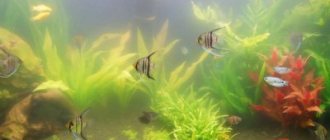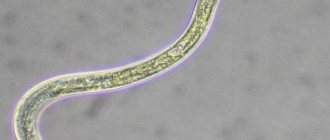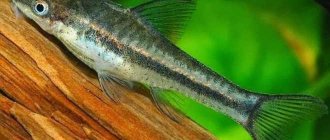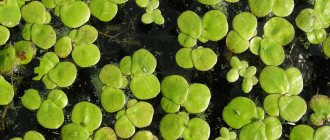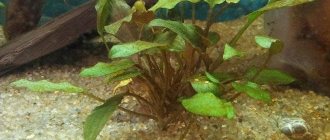Description
Beautiful chromis have an elongated body measuring 12–15 cm. The sides, fins and body are covered with greenish or bluish round spots. The appearance of the handsome varieties differs in the location of dark spots on the body. Everyone has one in the middle of their torso. The second spot near the anus of a two-spotted beauty. On the gills of hybrid species. In sexually mature individuals they sometimes disappear.
Most often the color is red. Shades from bright carmine to pink-orange. The back of handsome men is usually dark olive. The sides are greenish-pink.
The dorsal and anal fins are pointed. The caudal fin is rounded. The dorsal is long, occupies almost the entire back. The beauties are also called pearl cichlids, because of the blue luminous spots that cover the body and fins.
Features of behavior
Chromis handsome (hemichromis, red cichlid) has an aggressive character. They tend to undermine the soil and gnaw plants. Only hard-leaved species are selected.
When moving into a new aquarium, it takes 15–20 days to get used to it. During the adaptation period they are fearful. Housing conditions should be similar to the previous one.
After getting used to it, they divide the territory and drive away strangers. Even members of their own species. Therefore, there must be shelters in the reservoir where growing males and females can hide from mature individuals.
When they spawn, belligerence increases. During spawning, the partner sometimes kills the weak one. There are also peaceful-minded individuals. But the look is very aggressive.
Lifespan
The average lifespan of the chromis beauty fish in captivity is 4–5 years.
Varieties: Chromis neon and Hemichromis red
There are two types of aquarium fish that are varieties of chromis. They differ in size, thickness and body shape, as well as color.
We recommend reading
Apistograms: ramirezi, cockatoo, butterfly and others
Hemichromis red is another name for red stone, also known as red pearl. European residents have been growing this fish at home for hundreds of years, as it is an unpretentious species. The back color can be dark olive, and the body color can be pinkish-orange, dark purple and red. Due to its extremely bright color, hemichromis appears to glow. The scales shimmer with sky blue colors. The presence of dark spots with a blue tint gives the fish a mysterious effect.
Chromis neon - this species is native to Liberia, Africa and Congo. The neon pet lives in rivers, prefers the middle and lower layers, and adapts to hard water. The volume of the aquarium is at least 50 liters. Neon chromis are especially aggressive and unfriendly to other types of fish. They have a turquoise neon color, along the body there is a black spot, as well as light green spaces that sparkle like precious stones in the light. It lives in an artificial reservoir for no more than 5 years. Reaches sizes of 13-15 cm.
Kinds
There are four popular types of fish that are classified as handsome.
- Hemichromis Bimaculatus. Two-spotted, characteristic dark spots near the caudal fin.
- Hemichromis Guttatus. Tall-bodied, without dark spots, like the two-spotted one.
- Hemichromis lifalili. Different form of dorsal fin, no spot near the tail. This species is considered a real beauty of chromis. It is more peaceful than the tall-bodied or two-spotted.
- Hemichromis Bimaculatus II. An artificially bred subspecies. Very bright red color.
Species interact and interbreed. Therefore, hybrids of unknown origin are found in stores. Beautiful, bright colors and characteristic dark spots are characteristic of all species.
Content
With the right selection of neighbors and plants, keeping chromis fish does not require much effort. Use an aquarium with a size of 60 liters, and preferably 120–200 liters. The fish needs space. They love to hide, so take care of places for shelter: snags, grottoes, broken pots, caves.
Beauties need clean water, so change the liquid 25-30% weekly. Use a standard set of equipment: aerator, lighting, heater, external filter (internal, given the habit of breaking up the soil, is not suitable).
Water
| temperature | 22–28°C |
| acidity | 6,0–7.5 pH |
| rigidity | 4–12 dH |
These are ideal conditions. But hemichromis are able to adapt to more severe conditions.
Plants
Red cichlids dig the soil, tearing out plants and algae with roots, and gnaw leaves. Therefore, when planting plants in an aquarium, select ones with a powerful root system and hard leaves that can withstand attack. Use Anubius for planting. It fits better.
You can also use other hard-leaved species with creeping and strong roots. Or strengthen the roots with heavy stones when planting. Some aquarists bury plants already planted in a pot in the soil of the aquarium.
Priming
For soil, use stones: crushed stone, fine gravel or pebbles. When using sand, the water will be cloudy due to constant swarming at the bottom. Clean the soil weekly to remove fish waste and debris.
Lighting
Lighting for red cichlids should be bright, especially during the spawning period, but the aquarium must have shaded areas. Use fluorescent lamps.
How to keep Chromis handsome
How long chromis live in an aquarium largely depends on maintenance and care. The conditions include not only water parameters and arrangement, but also the neighborhood, the number of stressful situations, and the regularity of cleaning. With good care, the life expectancy of hemichromis is 5-6 years.
Arrangement of the aquarium
- water volume – minimum from 70 l. Desirable - at least 120 liters per couple. The more space, the higher the likelihood that all the fish will find a place for themselves, and a war for territory will be avoided;
- the soil is suitable for a fine fraction - 3-5 mm. Fish will constantly dig through the sand, raising mud, and too large stones can cause injury. Chromis love to restore order, and it is better if they have this opportunity;
- filtration and aeration are required. Special attention should be paid to aeration: beautiful chromis love oxygenated water;
- the decor should contain many hiding places, holes and holes. The more fish there are, the more minks there should be. Suitable sandstone and volcanic tuff piles, as well as ceramic jugs, pipes, etc.;
- plants are preferably artificial or live with a good strong root system. Anything that is poorly attached will be dug up by the fish and either eaten or scattered around the aquarium;
- lighting – moderate, with shaded areas;
- a lid is required - pearl cichlazomas are jumping.
Water parameters
- temperature 22-26°C
- hardness 4-20°;
- acidity 6.8-7.5 pH;
Maintenance and care
- regular cleaning of the soil from detritus - at least 1-2 times a month;
- weekly change of a quarter of the volume of water (usually combined with soil cleaning).
Feeding
The aquarium fish Chromis has an excellent appetite. He eats a lot and whatever is given. Therefore, when feeding handsome chromis, calculate the serving size and stick to it. Otherwise, the fish will overeat and die.
Handsome animals are omnivores, but prefer animal protein foods. They are also carnivores, and their diet should include meat. The main foods for hemichromis are:
- live food - bloodworms, tubifex, fish fry, earthworms;
- meat - thin slices of beef, shrimp;
- chopped lettuce, pieces of cucumber, zucchini, food containing spirulina;
- artificial industrial food for cichlids.
If you do not have experience keeping such fish, then start with store-bought food for cichlids, and then gradually select the diet. Feed adult chromis once a day, sometimes twice. Fry and growing young fish 4-5 times a day. Give your chromis food in large pieces.
Calculate the size of one serving based on the volume of food eaten in 20 seconds.
Features of keeping red cichlids in an aquarium
To provide a beautiful inhabitant with decent and comfortable conditions, it is necessary to provide for the following nuances:
- chromis require an aquarium with a volume of at least 200 liters - more cramped conditions are contraindicated for such territorial and aggressive fish;
- the tank should be equipped with various decor - grottoes, pots, caves, hollow pipes and driftwood - cichlids love to sit in secluded places;
- It is better to take sand as a ground material, since digging in it and raising mud is a favorite pastime of handsome chromis;
- Cichlids need clean water - they should be changed regularly;
- It is advisable to equip the aquarium with an external filter - an internal one is not suitable due to the fish’s love of digging up the soil;
- It is recommended to carry out a “siphon” - cleaning the bottom regularly.
Chromis and vegetation are not the best combination; all tender leaves will be eaten and torn off, and weak roots will be dug up. It is better to plant tough plants for aquariums - Anubias, etc. or buy them directly in pots.
Soft water with a value no higher than 12dGH is best suited for chromis, although they are able to adapt to hard water. It is better to maintain the water temperature within 25°-28°C, pH 6.0-7.8.
Compatibility
The handsome chromis are an aggressive species and only fish similar in size to them and capable of repelling them get along with them:
- Akara;
- eight-banded cichlazoma;
- American cichlids;
- large barbs;
- chainmail, armored and other large catfish.
Do not place small leisurely fish (guppies, neons, zebrafish, mollies, etc.) or with lush fins (angelfish) with chromis. Snails, frogs and shrimp are also not compatible with beauties. They will gnaw off the horns of large snails, and simply eat small ones.
If several beauties live together, remember that they are territorial fish and will share the territory. Therefore, place a large driftwood or large object in the aquarium to create a border. This will help the fish divide the territory.
Compatibility and maintenance with other types of fish
The handsome one is very aggressive, especially when preparing for breeding. If you keep several pairs of pets in one aquarium, it is very interesting to watch how they divide the territory and constantly “quarrel”. It is possible to pacify aquarium inhabitants after establishing a boundary (for example, dividing the bottom into two parts by driftwood). The volume of an aquarium for two pairs must be at least 130 liters.
There are known cases when the female died if the male did not like her in some way, therefore, during spawning, it is best to rid the couples of their neighbors so that there are no unnecessary irritants.
The best neighbors are fish commensurate with chromis:
- catfish (armored, chain-mailed, fringed catfish);
- Akara;
- large barb.
The favorite soil of ray-finned fish is sand (it is easy to pick out plants and edibles from it), however, it is best to use crushed stone for maintenance, since due to the increased activity of the cichlid after feeding, turbidity from organic residues will constantly form. It is also important to regularly blow out the soil and change the water in the aquarium every week.
We recommend reading
Brocade catfish pterygoplichtas
Rocks and models of sunken ships are places where fish feel safe. The best plant for beautiful chromis is anubias (it has a strong root system and is well anchored in the ground).
Reproduction
Breed beauties at home in a separate large-volume aquarium of 100 liters or more. It's called spawning. It is possible in general, but you need to protect the fry and neighbors in the aquarium, because during the spawning period, chromis are more aggressive than usual. The period of sexual maturity in the red cichlid occurs at 6–9 months.
Sex differences
It is difficult to visually distinguish a male from a female. Sex differences are not clearly expressed. Males have brighter colors and are larger in size. Female chromis have a more rounded abdomen.
Pair formation
When breeding beauties, the creation of a pair plays a major role. Because if the partners don’t get along, they can kill each other. The couple is created forever and remains monogamous. Buy a pair that has already been created in the store.
If you are planning to raise handsome dogs on your own and create a couple, then start by getting to know each other. For example, in an aquarium through a barrier or glass. When the male and female do not show aggression towards the partner, then they can proceed to spawning.
Preparing for spawning
Place large flat stones on the ground in the aquarium. The eggs will be laid there. For stimulation, increase the water temperature to 27–29°C. The medium must be neutral or slightly acidic.
Spawning
When the pair has formed, spawning begins. In males the color becomes brighter. And blue or green spots begin to glow. But not for all individuals. He begins to form shelters, dig holes, and clears flat stones of debris.
It is important that the female is ready for spawning. If she is not ready, move her away temporarily. Otherwise, it may become a victim of the male. Watch the couple especially carefully.
To get a large litter, place several females and one male in the spawning aquarium, he will come into contact with each one. But the female, abandoned by the male, eats her offspring. She needs to be moved to another tank.
During one clutch, the female lays 300–600 eggs on a pre-prepared flat stone. The chromis parents then guard the clutch, aggressively chasing away other fish. The male digs holes in the ground, where the fry hide after hatching.
Larvae and fry
The hatching period of the fry is 2–4 days. The female periodically hides her offspring in new burrows. The first food for the young will be the yolk of the sac from which they hatched. After 3-4 days they already feed on Artemia eggs and daphnia.
When the offspring grow to a size of 1 cm, and this occurs by the 10th day of life, they are removed from their parents into a separate aquarium. Before this, the male and female groom and care for the fry.
Life support
Handsome fish are quite unpretentious, so keeping them is not particularly difficult. You need to choose a suitable aquarium for them. For one pair of cichlids, a design from 40-60 liters is suitable. Hemichromis are very fond of spacious homes; they will be especially comfortable in tanks of 120 liters or more.
Close attention should be paid to the quality of the soil. Cichlids love to dig it up, especially during the spawning period, so it is better not to purchase sand. Large crushed stone will do, but the soil should be loose.
The aquarium needs to be equipped with decorations. You can place clay pots, underwater castles or sunken ships in it. But simple stone structures are also quite suitable. These items will become shelters for couples and will also serve as a prevention of territorial conflicts. The aquarium should be covered with a lid to prevent the fish from jumping out of it.
Chromis must have plants in their home. It is best to purchase anubias with a powerful creeping rhizome, since it can survive if the fish dig it up. When placing greenery in an aquarium, you should follow three rules:
- You need to purchase a plant with a strong root system.
- Large stones should be placed near the roots of the plants.
- The bush needs to be planted in a pot, and only then dug into the surface of the soil.
Feeding cichlids
The basis of the diet should be protein food. For beginners, you can purchase special formulations for cichlid fish. They are very easy to use. As you gain experience in caring for chromis, you should optimize their menu by combining different foods:
- meat - small pieces of beef and shrimp;
- live - bloodworms, tubifex, fish fry and earthworms;
- dry - food for cichlids and herbal supplement spirulina.
You need to feed the fish 1-2 times a day. The optimal portion is determined by the owner himself. It depends on the type of food and the number of individuals in the aquarium. It should be borne in mind that dry formulations are less nutritious than live food.
Juveniles and fry should consume food 3-4 times a day. Adequate nutrition will allow them to reach puberty by 6 months of age.
Getting offspring
Chromis are monogamous fish; they find their partner for reproduction and spawn only with him. But finding a female for breeding is quite difficult. It is difficult to distinguish a female from a male, and they must be compatible with each other. If partners don't match, they can be aggressive. Sometimes it even comes to murder.
When an owner introduces cichlids to each other for the first time, it is very important to monitor their behavior. If you are not careful, one of the fish may be found crippled or killed. If the cichlids have found a common language, the male begins preparations for spawning and his colors become brighter. It is necessary to take a closer look at the female; if she is not ready for spawning, the male may attack her.
Chromis are monogamous fish; they find their partner for reproduction and spawn only with him.
The female lays a lot of eggs (up to 500 pieces) on a clean, smooth surface. Most often, she chooses a stone for these purposes. The larvae hatch after two days and the female takes care of them. She will collect them and hide them in another shelter until they begin to swim on their own. This occurs approximately three days after they are born.
The male takes an active part in the life of the fry. He, together with the female, guards the babies and does not allow any fish to approach them. The fry are fed Artemia naupilium. It is worth paying attention to the fact that they should be sorted, since they eat each other. The parents will guard the fry until they grow to 1 cm in length, and then stop paying attention to them.
Handsome Chromis is a bright, unusual cichlid. This fish is suitable for both beginners and experienced aquarists. She is easy to keep and feed. With proper care, it will please its owner for a long time.
Chromis diseases
Beautiful chromis have good health, but failure to comply with the rules of maintenance and care leads to illness. When performing scheduled water changes, use special tests to check the water quality. High levels of nitrates and ammonia reduce immunity.
If your fish gets sick, move it to a separate aquarium so as not to infect your neighbors. For treatment, raise the water temperature to 31°C and add salt to the pond in a ratio of 5 g of salt per 1 liter of water.
Sometimes the cause of the disease is stress, aggression from neighbors, or a small aquarium.
Features of behavior
Chromis is a fish famous for its aggressive character. The handsome fish behaves restlessly in the aquarium - it undermines the soil and damages aquatic plants, so for decoration it is better to select only algae with hard leaves, which the fish will probably not like.
Adaptation to a new aquarium takes a lot of time for a fish - up to three weeks. All this time, chromis behaves restlessly and fearfully, trying to hide among the algae. To facilitate the adaptation period, if possible, it is better to recreate conditions that are as similar as possible to the fish’s previous home.
After adaptation, chromis will begin to share the territory with other fish. The handsome man will try to drive away not only strangers, but also his fellow tribesmen, especially if they are smaller in size. That is why secluded corners for growing individuals should be prepared in advance in the aquarium.
Chromis becomes especially aggressive during the spawning period. In order to prevent fights in which a stronger fish is able to destroy a weaker one, it is better to place the fighters in separate containers at this time.
There is no point in conducting experiments on the compatibility of a handsome man with other representatives of the aquatic family; it is better to use useful recommendations. Fish that are not timid and capable of repelling a fighter can easily get along with chromis:
- cichlazoma eight-striped;
- Akara;
- Lionhead cichla.
It is better not to stock small fish with chromis - already on the first night their number will decrease significantly.
Reviews
Owners of red cichlids complain about the fish’s aggression and pay attention to the choice of aquarium inhabitants. Plants are severely destroyed and artificial ones are used.
